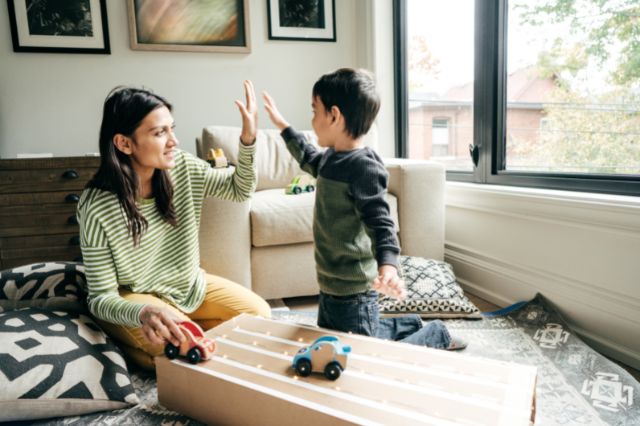Gestalt Language Processing

Echolalia is NOT a language disorder, it’s the first stage of Gestalt Language Development. Did you know…. There is more than one way to acquire and develop language!
Myth: Children start learning language by learning certain words.
Fact: Any child starting the language development process will be processing units. Two terms to understand regarding this are “Analytical Language Processing” and “Gestalt Language Processing”:
Analytic Language Processing ALP– Learning single units of language one at a time.
Gestalt Language Processing GLP– Learning language in phrases and sentences
Kids take “units” from speech they hear in context.
ALP: they extract one single word
GLP: they may pick up the whole phrase.
Similar to how or when we go to another country, we learn gestalts to get us what we need, and we memorize phrases.
EXAMPLE:
With context, we know that in the movie, that’s used to indicate when Luca is encouraged to do something brave. So, it may mean, “I’m scared.”If we repeat back the gestalt, we get way more buy-in than if we immediately correct what they said.
What are some signs my client is a GLP?
- May recite scenes from movies/shows while talking or playing OR act them out often with gestures or facial expressions.
- Speech is rich in intonation but may be unintelligible.
- Attend to music/intonation more than the speech.
- Kids who may not have made much progress with typical analytical therapy processes (i.e., ball, I + want + a +ball)
- They may respond to your question by repeating your question.
- They may feel most comfortable with consistent routines for sessions because they see that session with its expected transitions as a whole unit.
- It may be VERY hard for them to play with a toy that does not have all of its pieces (this would also make sharing very hard) because the toy is seen as a whole unit with all its pieces.
What should I do right now in therapy:
- Connection first with interests, then language teaching.
- Give more opportunities for silence in session so you can hear their gestalts.
- See what the child is doing when they say them, what the context is, and how are they feeling.
- Let them know you’re listening, even if you don’t yet know the context or can’t understand (i.e., I hear you, *nodding*)
- Jump into their script if you’re familiar with it, if not, become familiar with it so you can connect over that script.
Tell me about the stages
| Example using the song Let It Go from Frozen | |
| Stage 1 Gestalts | Exact phrases from a movie or show or experience (may just be intonation and not intelligible) |
| Stage 2 Mitigation “Mix and Match” | Parts of one combined with parts of another gestalt |
| Stage 3 Isolation & Combination of Single words | Single word parts mixed with other word parts from the gestalts |
| Stage 4 Self-Generated Phrases and Simple Sentences | Gestalts with a few new words to create novel phrases and sentences |
| Example using the song Let It Go from Frozen | |
| Stage 1 Gestalts | Let it go, Couldn’t keep it in, Be the good girl (may just be intonation and not intelligible) |
| Stage 2 Mitigation “Mix and Match” | Let it in, couldn’t keep the good girl |
| Stage 3 Isolation & Combination of Single words | Let it girl, keep it go good girl, |
| Stage 4 Self-Generated Phrases and Simple Sentences | Let me in, I’m good girl, you let it go |
| What do I do at each stage | |
| 1 | Talk naturally in sessions about their interests with lots of intonation (i.e., “Let’s play with the cars!” “The Itsy-Bitsy Spider went up the water spout) |
| 2 | Mix and match with phrases they use (i.e., Let’s play with the swing, Let’s play with the ball, This Itsy-Bitsy Spider went home) |
| 3 | Feels like we’re taking a step back, but we aren’t, our clients have isolated words in their language repertoire to the single-word level, so we are taking those words and making a variety of two-word combinations |
| 4 | We start thinking about grammar now, we may model “no car, ball!” or “Spider is over, now Old McDonald” |
Goal Ideas:
- STAGE 1: CLIENT will use 5 new gestalts/phrases in a 30-minute session given max modeling and cueing etc.
- STAGE 2: CLIENT will mix and match their gestalts/phrases to make new combinations (i.e., Let’s get + out of here, Go get + some more)
- Stage 3: Client will use single words to make new combinations of words given max modeling and cueing etc.
- Stage 4- Here is where we can start to target basic grammar.
Echolalia is NOT a language disorder, it’s the first stage of Gestalt Language Development!
Author Chloe Conrad received her Master of Science Degree in Communication Disorders from Arizona State University. She specializes in Pediatric Speech/Language Therapy and has extensive experience with articulation/phonology, Childhood Apraxia of Speech, Feeding, Autism and other communication milestones. She is passionate about neurodiversity and actively incorporates a strengths-based approach into her therapeutic practice. She commonly collaborates with the multidisciplinary team (speech, OT and PT) to assess and treat pediatric patients in our Tempe Clinic.
